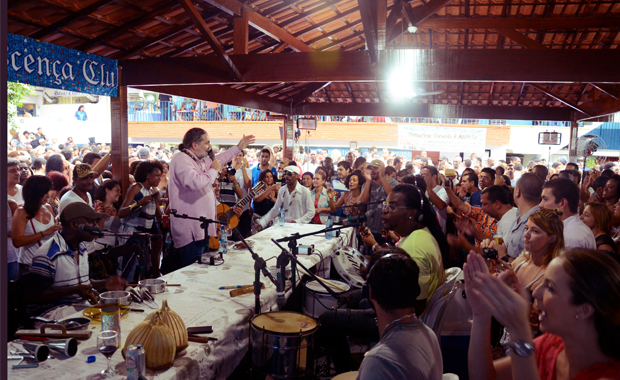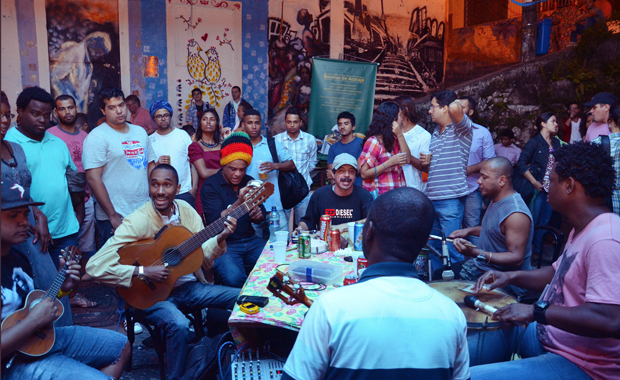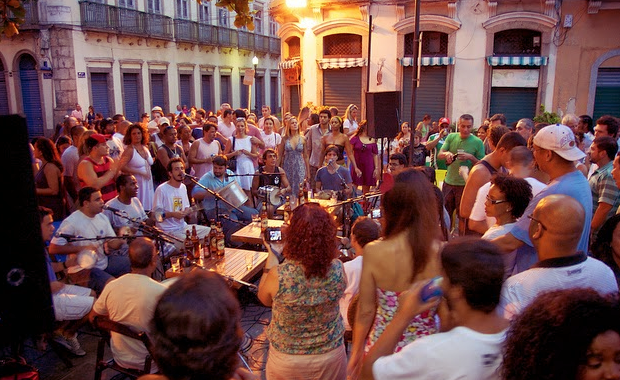When you visit Rio, make sure you go to an authentic “roda de samba”
Brazil is a cultural melting pot. Traditions were spread around the territory by the native Indians, the imported African slaves, Portuguese, Dutch, and after the 19th Century immigrants from all over, especially Italy, Japan and Germany. The point is: many legends, stories and myths were passed along generation after generation. And those originated cults and popular celebrations.
In this rich universe of Brazilian culture, dance has an especial spot in a combination of rituals and traditions from other times and lands. In Rio, one of these traditions is samba.
As a dance, it came from Bahia, known as “samba de roda”. Basically people gathered in a circle and made movements that used feet, arms and hips for women and arms and feet for the men. Once in Rio, then Brazilian capital, the dance gained expression, variations and became known as a typical carioca dance and music. Although there is still some “samba de roda”, through time it became a party for dance, music, poets and some good food.
Here you go an essential list of famous and democratic “rodas de samba” for you to go when visting the city.
- Samba do Trabalhador (Worker’s Samba)
Happens every Monday at Renascença Club, in AndaraÃ, Northern area of Rio. It lasts from 5PM till ’round midnight. Idea of a respected Brazilian composer called Moacyr Luz, it is not uncommon that famous samba or Brazilian Popular Music (MPB) singers and composers pass by and sing a song or two to delight the audience.

Photo: Alexandre Macieira | Riotur
- Samba da Pedra do Sal (The Salt Rock Samba)
It is one of the most ancestral places of African-originated culture in Rio. It is near the Valongo, ancient harbour where smugglers desimbarked the slaves after the British started to patrol the seas after traffickers ships. Recently it was declared a World Cultural site. An active black community developed in its surroundings, one of the birthplaces of samba in the city. At Pedra do Sal, at the foot of Morro da Conceição, those who enjoy a traditional samba de roda gather every Monday from 7PM on. They sing and play without amplifiers or mics. It’s in the middle of the street and vendors selling food and beverages circle the place.

Photo: Alexandre Macieira | Riotur
- Samba do Ouvidor
It’s a party that happens every two Saturdays at the corner of Rua do Ouvidor and Rua do Mercado, at downtown Rio. The place usually busy with people in suits since it is near Rio’s stock exchange building gets full of people looking for the drums and singing of these rodas de samba. It became so popular that the buildings around it, most of them subused or abandoned before now are full of bars and restaurants where you can enjoy some food before or after the gathering that goes from 3PM -10PM usually.

Photo: Niko Kaiser
- Samba schools
Most samba schools were born from samba de roda groups. Some of them still have parties like that from time to time. One of the most regular ones is named Portela de Asas Abertas. The school invites samba groups to sing and play in homage to some composer that was important in Portela’s history. It happens on Saturdays afternoons every two months and the tickets are usually R$ 15 (around US$ 5). You get to know Portela’s headquarters, dance, hear good samba and taste some of the treats the bars of the school have to offer. Next edition will be in September.
This is only a small sample of the samba activity in Rio. Recently the City Hall and a cultural institute started a project to map and register all regular “rodas de samba” in Rio. A preliminary research identified more that 150 events of the kind. The idea is creating an online platform where the organizers feed the information. All this to say: you have no excuse to leave Rio saying you didn’t go to any samba party because your visit happened in the off-Carnival season.

COMENTÁRIOS